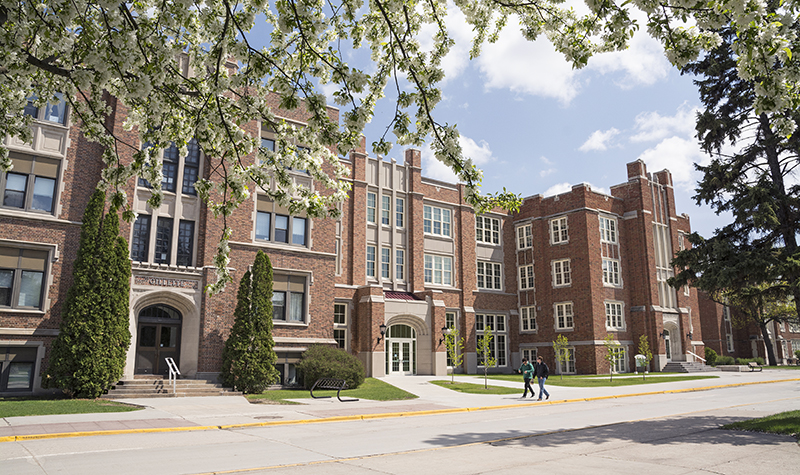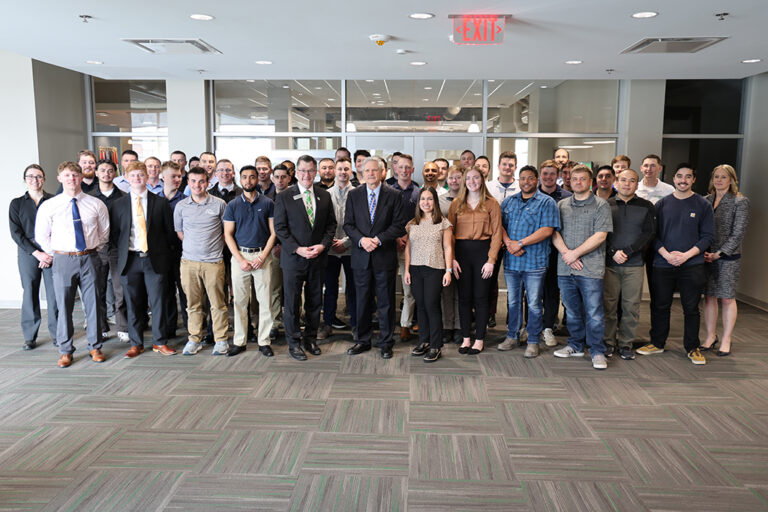UND’s student teachers help K-12 classrooms move online
Most of UND’s teachers in training have continued their classroom placements remotely amid COVID-19 pandemic

On Sunday, March 15, North Dakota Gov. Doug Burgum ordered all K-12 schools to close for what was then a week.
Senior Tiffanie Luschen felt the same way a lot of UND’s student teachers did that evening: panicked.
In the teacher education program at the College of Education & Human Development, more than 100 students are placed in classrooms as full-time student teachers each semester. Another 300 students, on average, are involved in some type of classroom placement for other courses.
Given the requirements of UND’s program and the situation at hand, it was understandable that Luschen and her peers were at the very least uneasy.

“I immediately texted my cooperating teacher and asked her if it was for real,” said Luschen, who had been working in a sixth-grade classroom at Thompson Elementary School, in Thompson, N.D. “I had no clue what I was going to do to finish my student teaching weeks, as I only had 10 completed out of the 16 required.”
That same evening, Jenny Bladow’s inbox was filling fast. As director of teacher education, she’s positioned as a liaison between K-12 schools and the College. She was one of the first people students wanted to turn to for answers.
“I think I had 100 emails within an hour,” Bladow said. “Most of them were asking, ‘What does this mean for me? What does this mean for field experiences?’
“We all had that feeling.”
Support from schools, state
The seriousness of the situation started to sink in for Luschen when she arrived to the school the next day not to students, but to teachers gathered to plan and clean their classrooms for sanitation.
“On Monday, we spent most of the day cleaning and throwing away all paper copies of basically everything we had around the room – assignments, projects and more,” Luschen told UND Today. “It was a little mind-blowing.”
The rest of the week had the school district focused on planning online curriculum and easing students’ stress and fears about what would happen. Since then, Luschen has been teaching from home in Grand Forks.
To the relief of Bladow and teacher education faculty, most student teachers have been able to carry on their classroom placements in the wake of school closures and a statewide shift to remote education. After a survey was sent to classroom teachers asking if they’d be willing to sign off on their student teachers’ time, or if they’d be interested in continuing collaborations, the response was overwhelmingly in favor of the latter.
The College also had the support of the state’s Education Standards and Practices Board to independently determine whether students have met requirements for field hours. Overall, the goal has been to work with students as needed to make sure nobody has to delay graduation or repeat courses.
“Thankfully, most student teachers this semester had already completed 10 weeks of teaching,” Bladow said. “That is the amount of time required by North Dakota for licensure, Minnesota requires 12 weeks. At the College, we go above and beyond in requiring 16 weeks.”
But for courses such as Intro to Education, where certain amounts of hours in K-12 classrooms are expected over the course of a semester, requirements are being shifted to accommodate an unusual situation. For students who still don’t meet the new requirements, Bladow says alternative experiences are being developed to fulfill course goals.
“If their field experience is to design a lesson or teach to students, for instance, then we might set up something where those students record themselves teaching the lesson and send it out,” Bladow said. Given the time of the semester in which in-person instruction was restricted, alternative experiences are most likely going to be handled on a case-by-case basis.

Staying positive
Since January, Luschen had been teaching most subjects in her class of 19 sixth-graders. When it came time to decide how online learning would be handled, she transitioned to teaching solely math and social studies. She said it hasn’t been an easy transition, but the students are handling it well.
At the school, each student had been assigned a Chromebook, so parents came to the school to pick up classroom materials and a computer so students could log in to Google Classroom to watch lessons and complete assignments.
Luschen records 15-20 minute lectures and posts them each morning at 8 o’clock. Students are expected to watch them and take notes like they would in class. Afterward, they have questions to complete that are based off of what was covered in the video.
At 1 p.m., Luschen hosts a Google Meet chat with her class to talk about the lessons, but it’s also a good opportunity to lighten the mood.
“I like to keep some of the same style and techniques that we used in class as it can help ease the stress for most of them,” she said. “Knowing I won’t get to see my students in person and have one last regular class with them breaks my heart, and I wish I could change all this for them.”
The senior, who was offered a position in the Middle Level Resident Teacher Program and plans to start graduate school courses in June, has kept a positive attitude throughout the ordeal.
“It really has been a great learning experience,” Luschen said. “Being flexible, understanding students’ home lives and knowing that each student has a million other things to worry about besides school is something I really empathize with now.
“I feel as if this unusual experience has made me a more sympathetic and empathetic teacher, and it’s really helped me cherish the simple things like our everyday math activities, me reading aloud to them and our morning meeting time.”
Opportunity through adversity
Bladow recognized the opportunity for student teachers to see the resiliency, collaboration and dedication from full-time professionals in providing young people consistent education.
In the surveys sent to collaborating teachers and school administrators, many valued the tech-savvy abilities of their younger counterparts that have made transitioning to remote instruction that much easier.
“It’s an opportunity for our students to learn through this, and to learn right alongside those that are out in the trenches, so to speak,” Bladow said. “Our students going through this right now are going to have those extra skills and more tools in their toolbox that other semesters of students haven’t had.”



